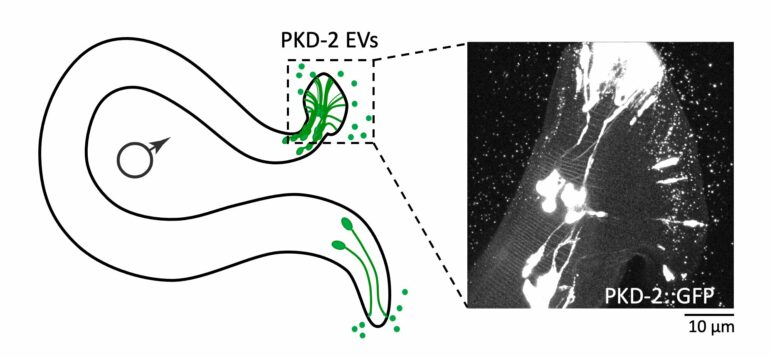Scientists have long puzzled about a critical way that cells communicate with one another, but Rutgers researchers have used a simple roundworm to solve the mystery.
The study, which appears in the journal Current Biology, could help to develop treatments for Alzheimer’s and other neurodegenerative diseases.
Cells share good news and bad news with each other, and one way in which they do that is through tiny bubbles called extracellular vesicles (EVs). Once considered to be cellular debris, EVs carry beneficial or toxic cargo that promotes good health or disease. In the human brain, for example, EVs carry disease-causing proteins that may influence the progression of Alzheimer’s disease.
“Although EVs are of profound medical importance, the field lacks a basic understanding of how EVs form, what cargo is packaged in different types of EVs originating from same or different cell types and how different cargos influence the range of EV targeting and bioactivities,” said lead author Inna Nikonorova, a postdoctoral researcher.
EVs, which are found in human fluids including urine and blood, may be used in liquid biopsies as biomarkers for disease because healthy and sick cells package different EV cargo.
The Rutgers’ research team decided to use a simple experimental animal—C. elegans, or roundworms—and cutting edge genetic, molecular, biochemical and computational tools to study the unknown function that EVs have within our bodies.
Maureen Barr, a professor in the Department of Genetics, and Nikonorova developed a large-scale identification project that identified 2,888 EV cargo candidates.
Given the importance of EVs in the human nervous system, Nikonorova focused on EVs produced by cilia, the cellular antennae that transmit and receive signals for intercellular communication. Specifically, the researchers focused on EV cargo produced by nerve cells and discovered that EVs carry RNA-binding proteins as well as RNA, whose role in effective therapies is seen in the COVID-19 mRNA vaccine.
Nikonorova and Barr hypothesized that neurons package RNA-binding proteins and RNA into EVs to drive communication between cells and between animals. A fundamental understanding of EV-RNA biology is important for developing tailor-made EVs for RNA-based therapies.
“We developed an innovative method to label, track and profile EVs using genetically encoded, fluorescent-tagged EV cargo and conducted a large-scale isolation and protein profiling,” Nikonorova said. “Using this strategy, we discovered four novel cilia EV cargo. Combined, these data indicate that C. elegans produces a complex and heterogeneous mixture of EVs from multiple tissues in living animals and suggests that these environmental EVs play diverse roles in animal physiology.”
Future efforts in the Barr laboratory will be directed toward understanding EV-mediated RNA communication.
More information:
Maureen M. Barr, Isolation, profiling, and tracking of extracellular vesicle cargo in Caenorhabditis elegans, Current Biology (2022). DOI: 10.1016/j.cub.2022.03.005. www.cell.com/current-biology/f … 0960-9822(22)00396-7
Provided by
Rutgers University
Citation:
Once called cellular debris, tiny bubbles may play key role in understanding, treating diseases (2022, March 24)



